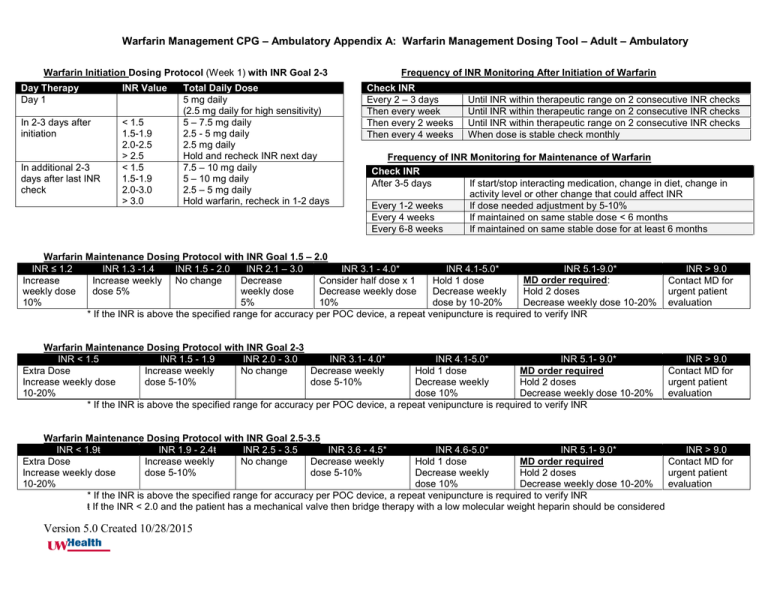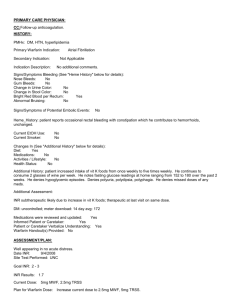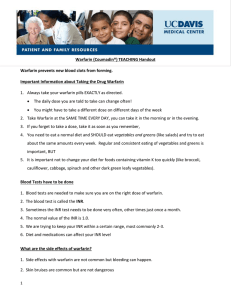Warfarin Dosing Guide: INR Management Protocol
advertisement

Warfarin Management CPG – Ambulatory Appendix A: Warfarin Management Dosing Tool – Adult – Ambulatory Warfarin Initiation Dosing Protocol (Week 1) with INR Goal 2-3 Day Therapy Day 1 INR Value In 2-3 days after initiation < 1.5 1.5-1.9 2.0-2.5 > 2.5 < 1.5 1.5-1.9 2.0-3.0 > 3.0 In additional 2-3 days after last INR check Total Daily Dose 5 mg daily (2.5 mg daily for high sensitivity) 5 – 7.5 mg daily 2.5 - 5 mg daily 2.5 mg daily Hold and recheck INR next day 7.5 – 10 mg daily 5 – 10 mg daily 2.5 – 5 mg daily Hold warfarin, recheck in 1-2 days Frequency of INR Monitoring After Initiation of Warfarin Check INR Every 2 – 3 days Then every week Then every 2 weeks Then every 4 weeks Until INR within therapeutic range on 2 consecutive INR checks Until INR within therapeutic range on 2 consecutive INR checks Until INR within therapeutic range on 2 consecutive INR checks When dose is stable check monthly Frequency of INR Monitoring for Maintenance of Warfarin Check INR After 3-5 days If start/stop interacting medication, change in diet, change in activity level or other change that could affect INR Every 1-2 weeks If dose needed adjustment by 5-10% Every 4 weeks If maintained on same stable dose < 6 months Every 6-8 weeks If maintained on same stable dose for at least 6 months Warfarin Maintenance Dosing Protocol with INR Goal 1.5 – 2.0 INR ≤ 1.2 INR 1.3 -1.4 INR 1.5 - 2.0 INR 2.1 – 3.0 INR 3.1 - 4.0* INR 4.1-5.0* INR 5.1-9.0* MD order required: Increase Increase weekly No change Decrease Consider half dose x 1 Hold 1 dose weekly dose dose 5% weekly dose Decrease weekly dose Decrease weekly Hold 2 doses 10% 5% 10% dose by 10-20% Decrease weekly dose 10-20% * If the INR is above the specified range for accuracy per POC device, a repeat venipuncture is required to verify INR INR > 9.0 Contact MD for urgent patient evaluation Warfarin Maintenance Dosing Protocol with INR Goal 2-3 INR < 1.5 INR 1.5 - 1.9 INR 2.0 - 3.0 INR 3.1- 4.0* INR 4.1-5.0* INR 5.1- 9.0* MD order required Extra Dose Increase weekly No change Decrease weekly Hold 1 dose Increase weekly dose dose 5-10% dose 5-10% Decrease weekly Hold 2 doses 10-20% dose 10% Decrease weekly dose 10-20% * If the INR is above the specified range for accuracy per POC device, a repeat venipuncture is required to verify INR INR > 9.0 Contact MD for urgent patient evaluation Warfarin Maintenance Dosing Protocol with INR Goal 2.5-3.5 INR < 1.9ŧ INR 1.9 - 2.4ŧ INR 2.5 - 3.5 INR 3.6 - 4.5* INR 4.6-5.0* INR 5.1- 9.0* INR > 9.0 MD order required Extra Dose Increase weekly No change Decrease weekly Hold 1 dose Contact MD for Increase weekly dose dose 5-10% dose 5-10% Decrease weekly Hold 2 doses urgent patient 10-20% dose 10% Decrease weekly dose 10-20% evaluation * If the INR is above the specified range for accuracy per POC device, a repeat venipuncture is required to verify INR ŧ If the INR < 2.0 and the patient has a mechanical valve then bridge therapy with a low molecular weight heparin should be considered Version 5.0 Created 10/28/2015 Warfarin Management CPG – Ambulatory Appendix A: Warfarin Management Dosing Tool – Adult – Ambulatory Dosing Tips: • If INR is above or below therapeutic range ≤ 0.5 and previously stable or there is a specific temporary reason for INR to be out of range (ex. missed dose): then continue current dose and test INR in 1-2 weeks • If indicated a partial to full extra dose or partial to full held dose can be utilized based on INR and patient’s sensitivity to warfarin • Do not include extra or hold doses as part of a weekly dose adjustment • Weekly warfarin doses > 50 mg per week: o Smaller weekly dose adjustments should be targeted o Include extra or hold doses into the weekly dose adjustments o If an extra dose is indicated, avoid a full extra dose. Instead consider an extra half dose. Drug Interactions: most drug interactions affect the INR within 3-5 days of concomitant therapy Drug Interaction Weekly Warfarin Dose Adjustment Fluconazole Day 1 of interaction: Decrease weekly warfarin dose by 30% Metronidazole Sulfamethoxazole/trimethoprim Amiodarone Day 7 of amiodarone: Decrease weekly warfarin dose by 25% Day 14 of amiodarone: Decrease weekly warfarin dose by another 25% Rifampin All other drug interactions Target a 50% reduction in weekly warfarin dose after 2 weeks of dual therapy. Day 7 of rifampin: Increase weekly warfarin dose by 25% Day 14 of rifampin: Increase weekly warfarin dose by another 25% Target a 50% increase in weekly warfarin dose after 2 weeks of dual therapy. Adjust weekly warfarin dose if INR outside of therapeutic range after INR recheck Recheck INR 3 - 5 days After 7 days of dual therapy After 14 days of dual therapy After 21 days of dual therapy (if INR within goal then follow maintenance INR monitoring table) After 7 days of dual therapy After 14 days of dual therapy After 21 days of dual therapy (if INR within goal then follow maintenance INR monitoring table) 3 – 5 days Progress Note Documentation: • “.Anticoagplan” – use for documenting warfarin management plan • “.Anticoagassess” – use for documenting patient findings (positive/negative) table • “.Anticoagmessage” – use for documenting when unable to reach a patient Anticoagulation Episode of Care Workflows • To create a new episode use the “Enroll in Anticoagulation” order (found in order entry) • Resolve the episode using the “discontinue therapy” button in the tracking section when a patient discontinues warfarin therapy, transfers care outside of UW Health or is deceased. • If a patient transfers care within UW Health, the receiving clinic must resolve the current episode and re-enter a new Enroll in Anticoagulation order to reactivate the episode with their clinic specific information. Discontinuing Warfarin Version 5.0 Created 10/28/2015 When warfarin therapy is discontinued completed the following check list: Resolve the episode using the “discontinue therapy” button in the tracking section Check for open orders related to monitoring warfarin (ex – INR) and discontinue Medication list – remove warfarin from the patient’s medication list Problem list – remove any problems related to managing warfarin (ex. long-term monitoring of anticoagulants)

